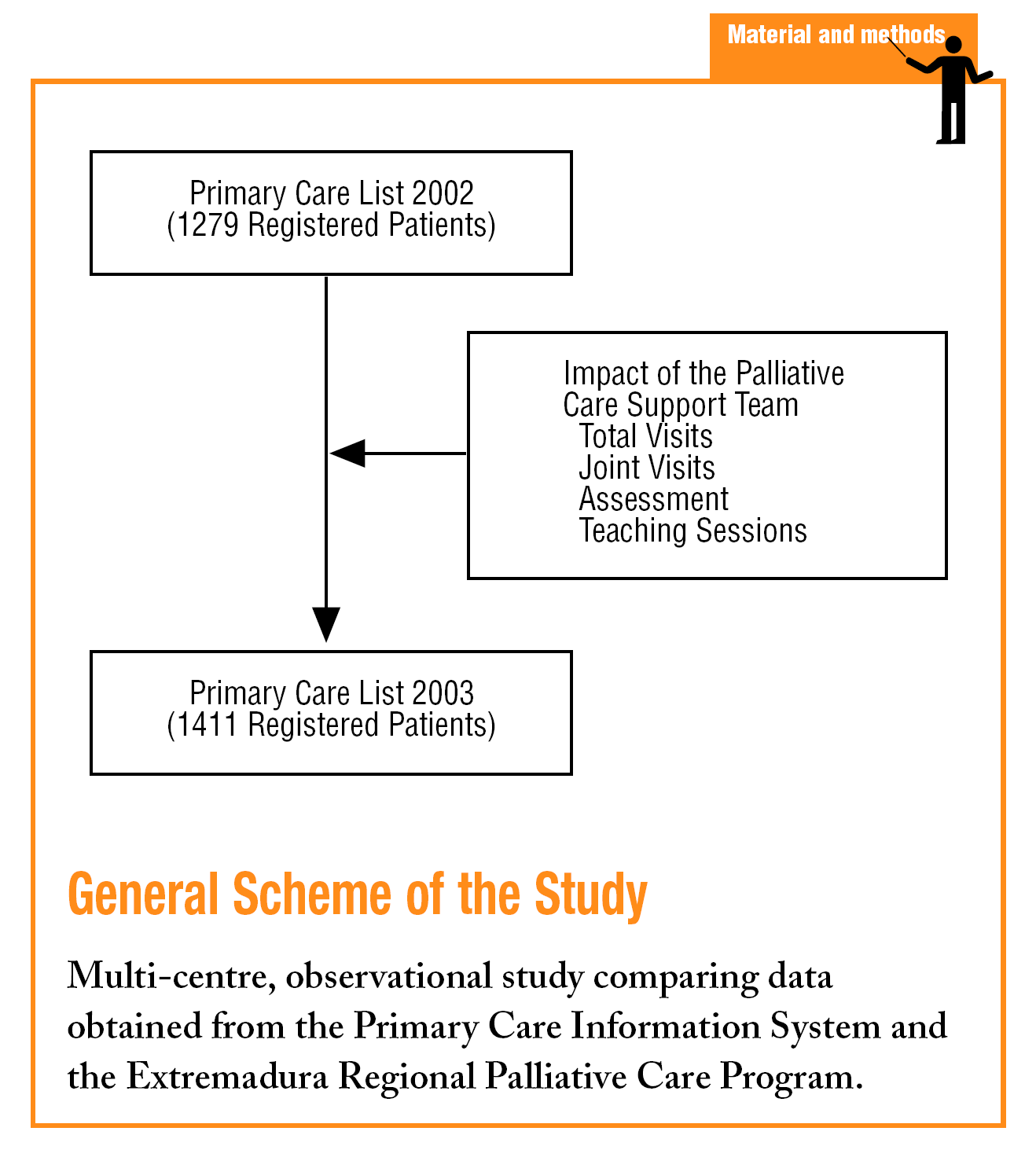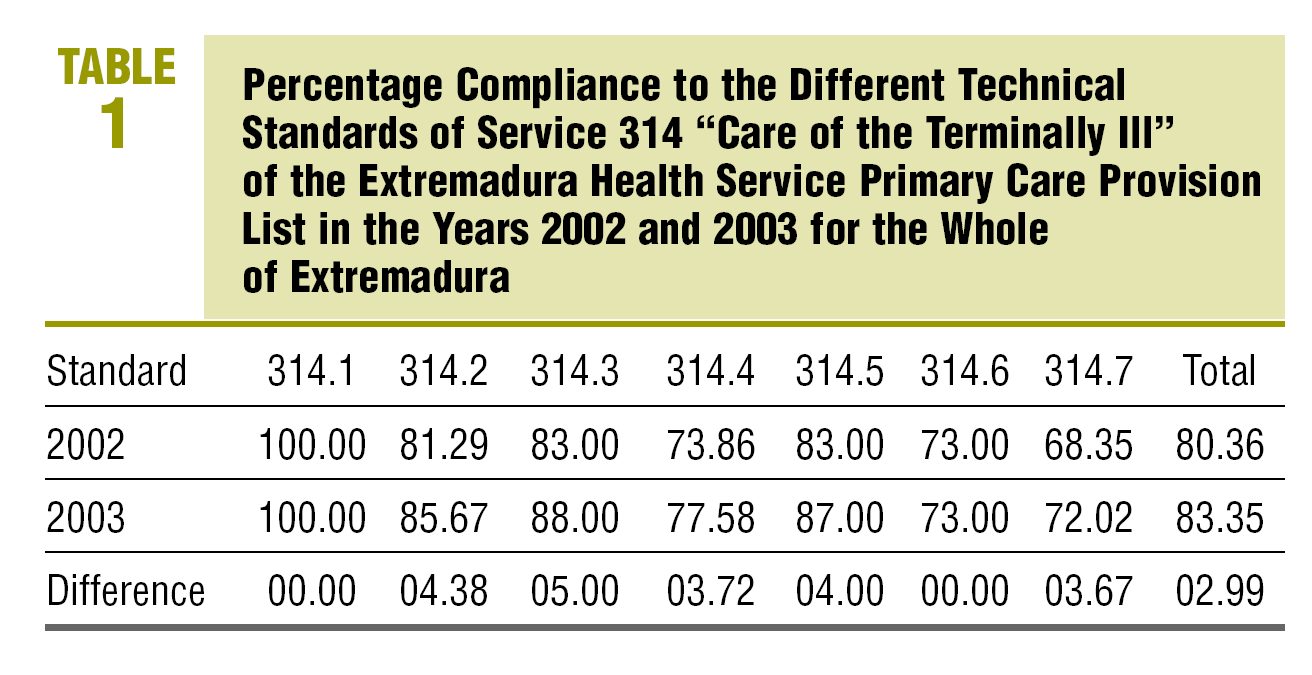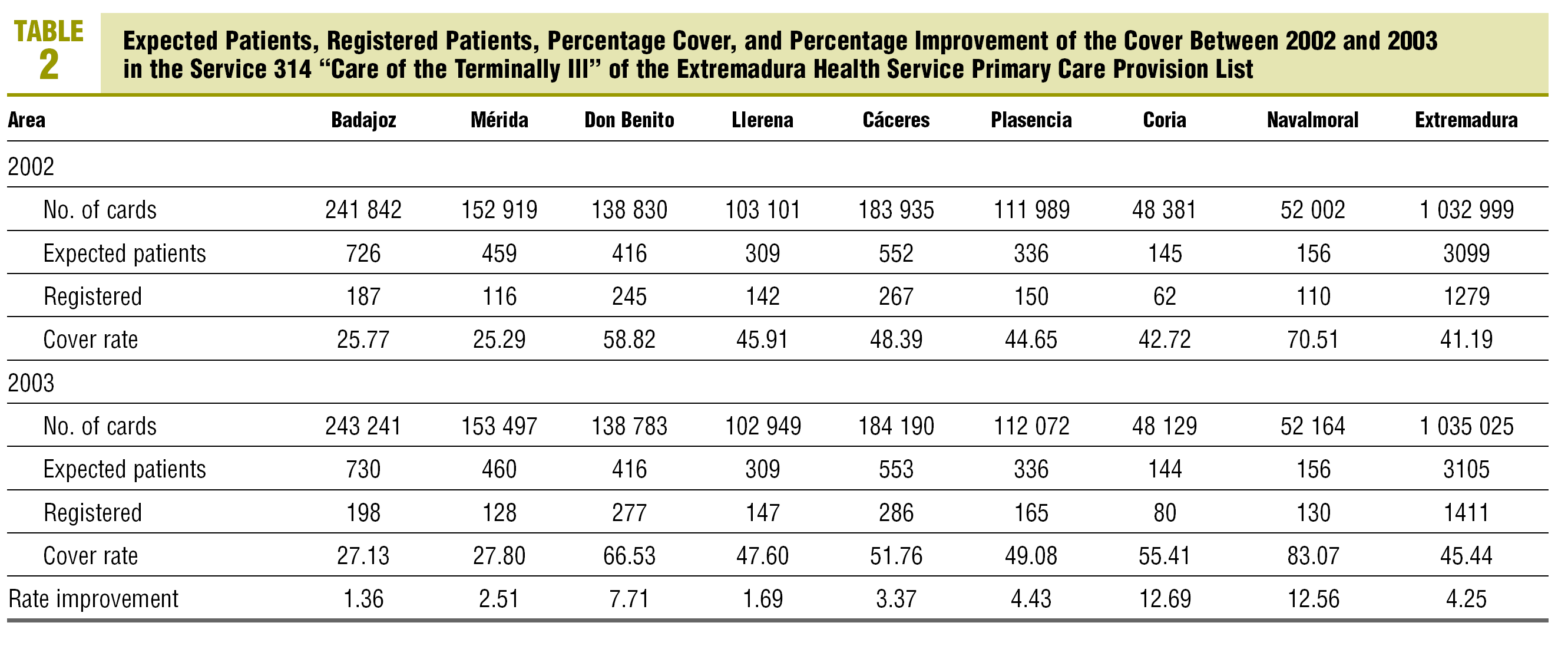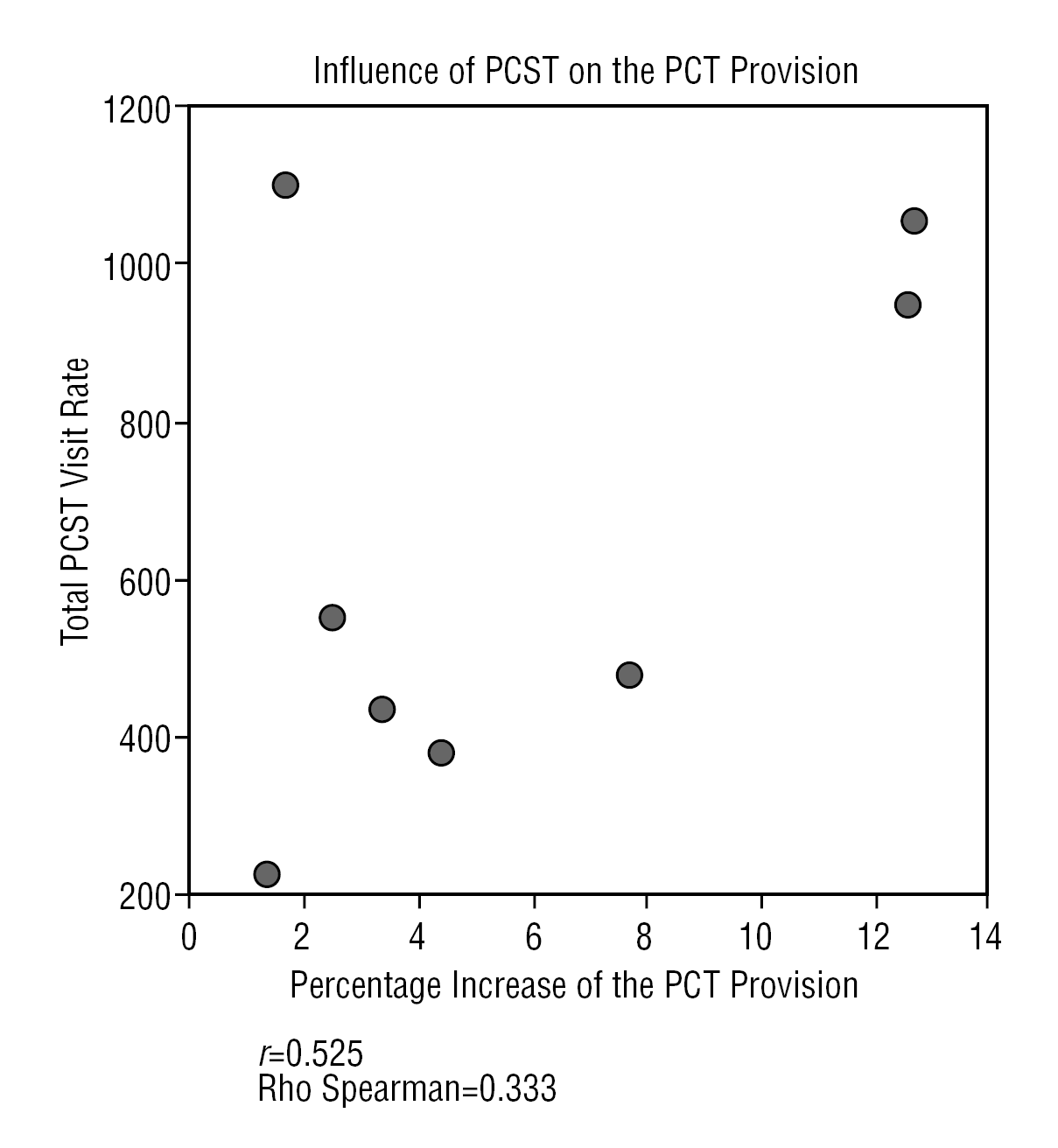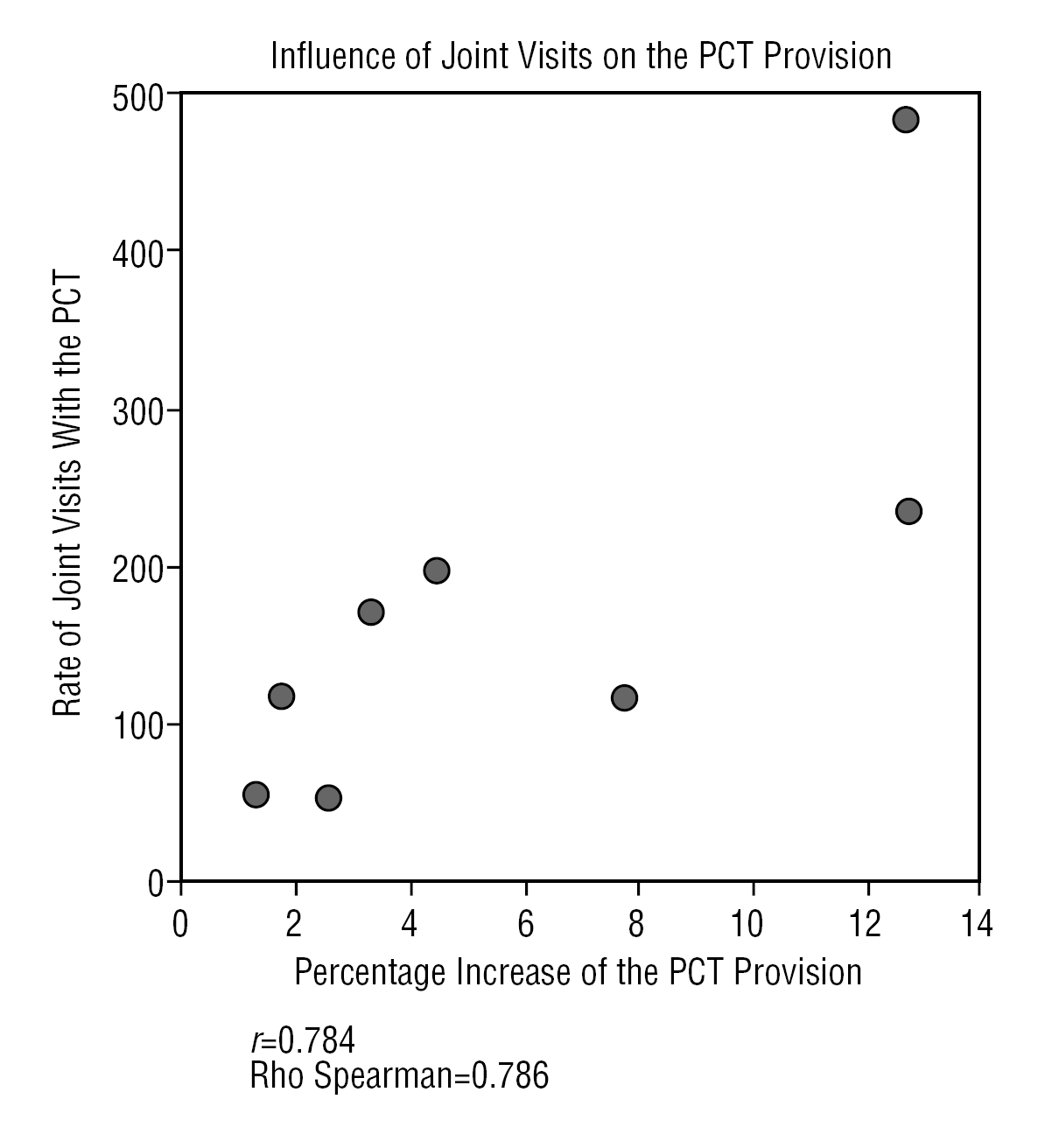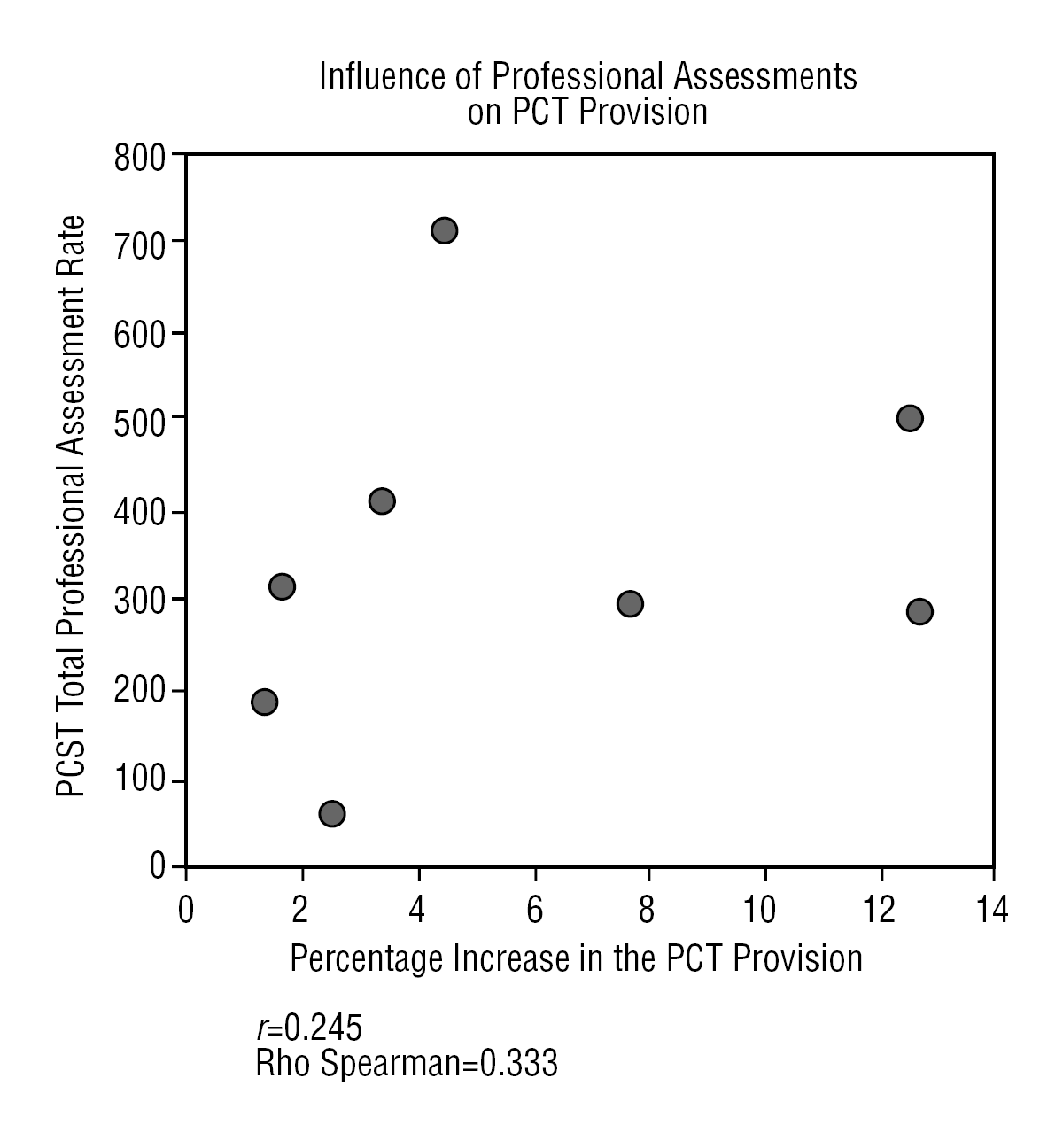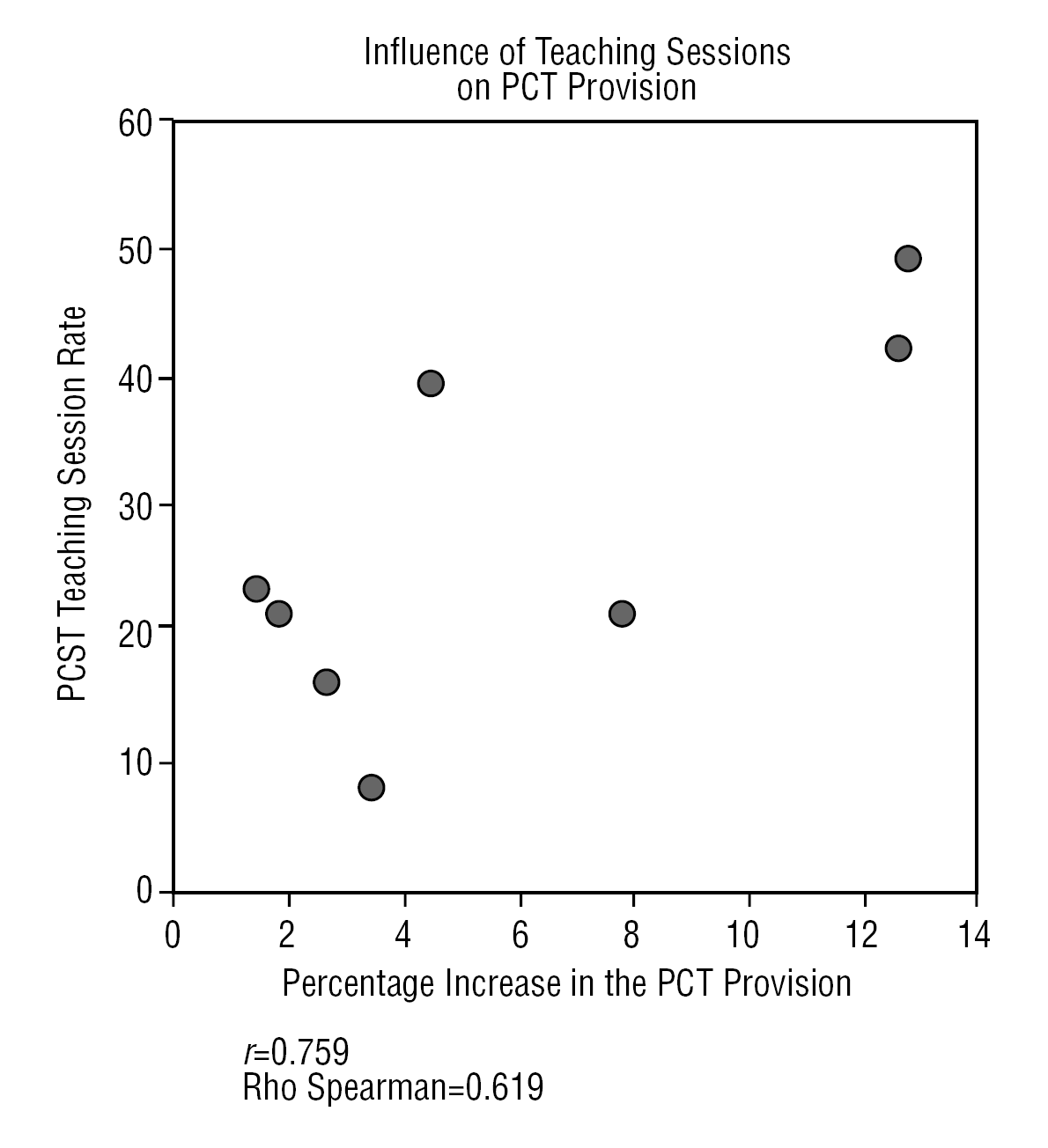y 23,14 sesiones docentes. Las visitas conjuntas y las sesiones docentes se asociaron fuertemente con una mejora de cartera de atención primaria (correlación de Pearson de 0,784 y 0,759, respectivamente). Las visitas totales tuvieron una asociación moderada (0,525) y las asesorías, una asociación débil (0,245). Conclusiones. Las visitas conjuntas y las sesiones docentes de un ECP se asocian con un aumento de la actividad de los equipos de atención primaria. Asesorías y visitas totales no influyen negativamente.
Introduction
The Law of Cohesion defines the provision of palliative care in the National Health System as a service which must be provided by primary care as well as specialised care.1
Bosanquet, in 1999, set out to find a model in which the roles between primary and secondary care settings were well defined.2 The Spanish Society of Family and Community Medicine (semFYC) has a working group on Palliative Care and has defined the important role of primary care in the caring for terminally ill patients in the community.3
An editorial was published on this subject in 2001, where it emphasised that the creation of primary care support units (palliative care) has to be an exception and, where applicable, to be justified by a detailed analysis.4
Nowadays, different axioms are accepted in the care of terminally ill patients:
Palliative care has to be offered according to need and, therefore, symptomatic control and not make any differences between the basic illness (oncological or not), age, gender, the location, or care setting.5
The palliative care models have to pursue integrated systems. It is not about developing palliative care in the home or in acute hospitals, in residences or long stay hospitals, but about developing a model that enables it to be offered.6
The role that the different professionals and care settings must develop has to be according to the symptomatic complexity and of the case in question, it must never try to duplicate the functions of primary care teams, since this leads to inefficiency.7
There are different levels of palliative care provision: primary (all health professionals), secondary (complex cases that can be resolved between disciplines), and tertiary (requires hospitalisation).8
Likewise, there are different levels of intensity in specific training which can prepare professionals to practice at levels of complexity of patients with a terminal illness.9,10
The degreee of development in each setting is very diverse in our country. Whilst training at primary level has been advanced, at tertiary level, the number of hospitals that have specialised teams or units is still insufficient.11,12
Coordinated and shared care has repeatedly been mentioned as the relationship format which can best lead to adequate support, always at the request of the professionals responsible for the case, and make the secondary level of palliative care possible.13
When faced with difficult cases, a team specially qualified in the treatment of complex symptoms can help to control the situation without the need for hospital admission. The role of the secondary PCST can be applied in the hospital setting as well as in the clinic or home setting.14,15
After many years of debate, there is another more developed and accepted criteria of the need for specific care in complex cases, but there remains an unresolved underlying question: is it really possible to develop a secondary level that can support and not replace the primary level of care? The lack of response to this question, and the logical concern and caution it provokes, has meant that such support may not have been adequately developed previously. Non-structured, non-organised palliative care teams in a health area can lead to a poor distribution of resources and, on the other hand, not offer solutions for all the needs.16
In 1991, Insalud established the basic service provisions that the users should receive from the primary care field. The service "Care of terminally ill patients" (Service No. 314) has always remained and is still one of only 13 which remain in the 8 current service lists.17
In January 2003, and after 10 months of intense work in preparing the project with the agreement of all parties, the Extremadura Regional Palliative Care Program began, with the objective that all patients would be able to receive the best care according to their level of complexity, offering them, primary, secondary, and tertiary care, equally throughout the region, and creating palliative care teams in each one of the 8 health areas. They are specific support teams of the process and act as support for the rest of the professionals, whether in hospitals, chronic centres or in the community. Besides the care of cases where their activity is required, one of their main functions is the teaching and training of other health professionals.15,16,18
The principal objective of this study is to demonstrate that the activity of palliative care support teams in Extremadura does not negatively influence the performance of the primary care "care of terminally ill patients" service.
Methods
A multicentre observational study has been designed, based on the comparing the variables of the activities of palliative care teams obtained from the Primary Care Information System (SiAP) of the Extremadura Health Service (SES) with those obtained by the coordination of the Extremadura Regional Palliative Care Programme (PRCPEx).
Using the data obtained from SiAP, the variable selected was the increase in the percentage of registered terminally ill patients (2003 as compared to 2002) in the provision of primary care services as regards those expected, taking an expected rate of 3 patients for every 1000 health cards as standard. The data is shown broken down into health areas in Table 1.
General Scheme of the Study Multi-centre, observational study comparing data obtained from the Primary Care Information System and the Extremadura Regional Palliative Care Program.
As regards the data obtained from PRCPEx, 4 variables have been used: total number of visits by the palliative care teams, number of joint visits by PCST in consultation with the professionals who requested the visit, number of assessments (recommendations, usually by telephone), and number of teaching sessions.
The normality of the 5 variables analysed have been checked using Kolmogorov-Smirnov test (Lilliefors correction) and the Saphiro-Wilk test.
The Pearson correlation has been used to estimate the association between the variables.
Results
In recent years, the primary care teams in Extremadura have attended increasingly more terminally ill patients and with a higher compliance to the technical guidelines of the service provision list (Table 1).
In 2002, the number of terminally ill patients was estimated to be 3099, and in 2003 it was 3105 (3 for every 1000 health cards). In the SiAP, in Extremadura, 1279 terminal patients were registered in the provision of services list in 2002 and 1411 in 2003, with a percentage cover rate of 41.19% and 45.44%, respectively (Table 2).
This meant that, according to the monthly activity statistics collected by the Regional Palliative Care Programme during 2003, which was the first year of activity of the specific palliative care teams, they assisted 1676 patients. In that year, the rates for each 100 000 health cards in Extremadura were 526.00 home visits; 86.1 joint home visits with the primary care team; 313.7 professional evaluations and 23.14 teaching sessions (Table 3).
The mean total of home visits for Extremadura was 526 for every 100 000 health cards. The rates ranged from, Navalmoral (224.02) to Plasencia (1095.50). This variable is positively associated with the improvement in the number of registered patients (r=0.52) (Figure 1).
FIGURE 1 Influence of palliative care support team visits on the primary care team provision.
The mean number of joint visits for Extremadura was 86.15, ranging from 37.55 in the Llerena area to 180.97 in the Don Benito area. There was a strong association with the improvement in numbers registered and primary care (r=0.78) (Figure 2).
FIGURE 2 Influence of joint Visits on the primary care team provision.
The association with the variable "professional evaluations" was weaker (r=0.25), with values ranging from 58.21 in the Caceres health area to 711.92 in Badajoz (Figure 3).
FIGURE 3 Influence of professional assessments on the primary care team provision.
Lastly, there was also a strong positive association with training sessions (r=0.76) (Figure 4) and ranged from 8.7 (Llerena) to 49.61 (Mérida).
FIGURE 4 Influence of teaching sessions on the primary care team provision.
Discussion
Taking into account that the investigation exclusively analyses procedure indicators, the data obtained shows that the joint visits along with the teaching sessions are associated with an improvement and a higher performance of the primary care service provision. The total visits (not joint) are associated, although to a lesser extent. These results are in agreement with those that some professionals had already indicated in 1999: "The requirements for primary care to take on palliative care is summed up in 3 main fields: coordination with other specialties,19,20 easy access to resources and continuous education."7,21,22
Also in 1999, Bruera established that the increase in participation by family doctors in the care of the terminally ill patients was one of the aims of a regional palliative care programme, and concluded that palliative care teams were not required for basic care, provided that the primary care teams had good training, pay, and support of clinical teams.23 In the year 2000, the same author, after studying the invoicing statistics, found that after a period of implementing a regional programme, the participation by family doctors in palliative care had been much higher (going from 33% to 90% of the care in only 5 years).24 Other authors have reported on the impact of palliative care teams, but we have not found any previous publications which measure the influence on the activity of primary care teams. For example, in a review carried out Critchley it was established that patients controlled by hospices without beds (specific home care) spent more time in their homes, died more often in their own homes and were less costly.25
In our study it is thought that the slight improvement in the indicators (introduction period) could be due to the positive confounding deterrent effect owing to the primary care professionals being aware that the care of terminally ill patients was to be an assessed element, particularly in the provision of services list in 2003 (Hawthorne effect).
The short study period (owing to the activity of the palliative care teams starting in 2003) limits the validation of the study. However, the preliminary figures of the provision list in 2004, a year in which there had not been any exhaustive measurement of the service, (cancelling out the Hawthorne effect), the increase was not only maintained but has tripled (a total of 1770 cases has been reached). Few authors have published the number of registered terminally ill patients in primary care. Alonso, in 1997, studied the activity in health centres in the Arganzuela district (in Health Area 11 in Madrid). With a population of 123 877 inhabitants and a mortality of 226 patients due to cancer, 139 of them were registered according to the clinical history, that is, 61.5% of those expected, a slightly higher figure than that registered by the primary care teams in Extremadura in 2003, taking into account that the bias of the measurement system was very different.26
It would have been desirable to set up this same study with the data broken down into at least basic health zones. With the palliative care information system in 2003, this level of detail could not be obtained. Throughout this year, an accumulated register of palliative care cases (RACIAL), which allowed the data to be broken down in more detail and, during the next 3 years, the integrated information system "JARA," which will include an electronic clinical history common to all care settings, will enable other, more detailed studies to be carried out where structural, procedure and results data may be compared.27
Two of the variables studied: joint visits and teaching sessions, have shown a higher association with improved primary care. The joint visits were already mentioned in SECPAL-semFYC consensus document in 2001 as one of the recommended forms of communication between professionals.3,28 Requena et al,29 in 2001, reported the activity of a primary care support team in its first year of functioning and stated that 29% of the patients had a joint follow up with the support team and the primary care team, although no details were given on the percentage of joint visits made.29
A study, presented at the Palliative Care Congress in Santander (1998), described a primary care programme in Pamplona with a support team which made 57 visits in the first 10 months of going into operation, all of them joint. Of the 19 health centres who took part in a satisfaction survey, 13 gave a very positive response. The number of joint visits in that study (57 in 10 months), for a reference population of around 180 000 inhabitants, was lower than the figure registered in Extremadura in 2003 (86 for every 100 000 inhabitants).30
The teaching sessions also appear to be associated with a positive impact. In 2001, the Palliative Care National Plan was published by the Ministry of Health and Consumer Affairs already pointed out that "training in palliative care is a priority for the whole care system (social and health) that is involved in this end of life care," "universities, scientific societies, and administrations should be involved to achieve a more efficient use of resources and implementation guarantees." Among the structure evaluation indicators that this plan suggests, is the percentage of target primary care and hospital services doctors and nurses, out of the total health personnel, with specific training, as well as the number of training activities in the different types of programmes.31
In 2001, Gómez and Gorchs described the activities of the Catalonian Centre for Palliative Care Studies, which offered 93 basic and 16 intermediate courses, as well as other activities, which were attended by 4681 health professionals between 1993 and 2001.32,33
Although the effect has not been well quantified, there are many studies which have predicted that, currently, the most effective measurement to ensure minimum care is to train the primary care professionals so that they can carry out a package of basic palliative care activities included in their service provision list.34-39
Some countries, including Spain, have begun continuous education training in palliative care for doctors and nurses from other specialties, knowing that this is the main tool to bring about a rapid change in the provision of palliative care.40
The total home visits showed a positive association near the expected limit on the activity of primary care teams. The total number of home visits by the palliative care teams in the first year of operation was 526 per 100 000 health cards, somewhat higher than that previously published by Cabrera in 1998, regarding a unit of the Spanish Association of the Fight Against Cancer, which was 416.41,42
The professional assessments were one of the most frequent activities of the PCSTs (313 per 100 000 inhabitants). They were weakly associated with the improvement in primary care and to a certain extent similar to those published in 1998 by the Pamplona team (615 calls per 180 000 inhabitants in 10 months).30
We conclude that the activity of palliative care teams does not appear to be associated with a decrease in primary care activity with terminally ill patients, and in fact the joint visits and the teaching sessions, in particular, are positively associated with an improvement in primary care.
Future studies should analyse the impact in more depth, study at which level of complexity higher efficiency is reached in each of the health settings, and measure the results obtained in the control of symptoms and the quality of life of the patients in each one of them.
What Is Known About the Subject
There are doubts on the need and functions that a palliative care support team has to take on.
The "care of terminally ill patients" service of the primary care provision defines terminally ill patient care.
Some authors and societies defend a role of support teams for the treatment of more complex cases.
What This Study Contributes
Despite the existence of support teams, primary care increasingly attends to more patients and with a higher quality.
Certain activities of the support teams (joint visits and teaching sessions, and to a lesser extent total visits) are strongly associated to an improvement in activity of primary care.
None of the activities of the support team negatively influences the compliance with the primary care service provision list.
Acknowledgements
Technical staff of the Extremadura Health Service Primary Care Department provided the evaluation data of the service provision list.
IPALEx Research Group, of the Extremadura Regional Palliative Care Programme, has collaborated in the collection of the activities data, and is composed of, besides the authors: M.A. Cuervo, M. Julián, R. Mota, F. Bonino, Y. Ruiz, F. Díaz, and R. Cabo (Badajoz); M.A. Sánchez, M.A. Martín, M. Blanco, and J.A. Garzón (Mérida); R. Pérez, A. Ayuso, M. López, and E. Alonso (Don Benito-Villanueva); A. Gómez, M.C. González, M.J. Barrera, and M.P. Ruiz (Llerena-Zafra); A.M. Durán, R. Valentín, F. Sáiz, V. Romero, J.A. Espinosa, T. Galea, and C. López (Cáceres); M.A. Sánchez, M. Ramos, P. Varillas, and V. Robles (Plasencia); R. Sánchez and A. Fernández (Coria); B. Pop and M. Gil (Navalmoral de la Mata).
Spanish version available at www.atencionprimaria.com/109.839
A commentary follow this article (pág. 323)
Correspondence:
Javier Rocafort Gil.
Coordinador del Programa Regional de Cuidados Paliativos de Extremadura. Servicio Extremeño de Salud.
Avda. de las Américas, 1.
06800 Mérida. Badajoz. España.
E-mail: jrocafort@arrakis.es
Manuscript received March 2, 2005.
Manuscript accepted for publication December 19, 2005.
This study has not received any funding from outside the Extremadura Health Service. Part of the results were presented at the semFYC Congress in 2004 by Dr Emilio Herrera.





